Courtship and Mating Behaviors
Biology 342 Fall 2016
Leilani Ganser and Piper Rodolf
Adaptive Value of Pipefish Courtship in Intertidal Zones
Courtship Adaptation
Adaptations often evolve due to shifting ecological and environmental stimuli such as the worm pipefish's ability to mate while maintaing a vertical position rather than horizontally as the majority of fish do. Adaptations such as these are typically the result of natural selection that has taken place over time due to a natural stimuli or development of a new challenge in an organisms ability to be reproductively successful.
A Father's Embrace
The courtship behavior of the worm pipefish is characterized by the lack of swimming and vertical embrace that the male and female maintain for a short time after courtship and spawning is complete. Their unusual mating is an adaptive trait that enables them to successfully mate in intertidal zones that have strong currents and inconsistent water levels. Without the males ability to carry the spawn in his pouch and the females ability to signal to the male that she is ready to be embraced and to place her eggs on her ventral side they would have very low reproductive success. Pipefish have reversed courtship roles as it is the female who initiates through her quivering, indicating to the male that she is ready to transfer her eggs and then embrace. The males ability to retain the eggs on his stomach ensures that they cannot be swept away, eaten, or dried out as is often common in intertidal zones with the varying water levels and strong curremts. While the females ability to initiate courtship and accept the males embrace ensures successful spawning.

a) Female quivers to signal to male that she is ready to mate. b)Spawning as female rubs against male to attach her eggs to his ventral side. c)Male rotates and intertwines his body around the female. d)Final embrace. (Source: acta ethol, Courtship Behavior of Pipefish)
